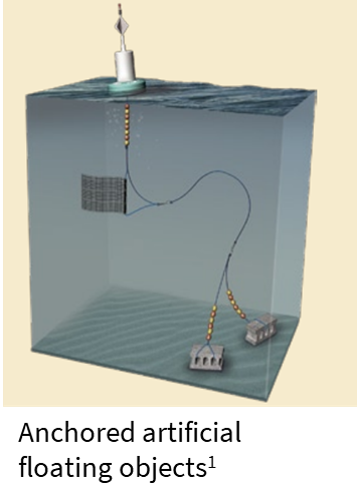Well-developed and implemented fisheries management plans can offset and reverse ecosystem decline. This is particularly important throughout the Pacific, where growing populations and climatic and non-climatic threats are placing unprecedented pressure on fishing stocks. To help support and maintain fisheries productivity, fisheries management approaches can be implemented that can benefit local communities, economies and the environment. Two of the dominant ecosystem-based approaches to managing fisheries stocks are through the establishment of marine protected areas (MPAs) and through the adoption of new fishing techniques, including the deployment of fish aggregating devices (FADs).
Methods
- Marine Protected Areas: Community-managed MPAs enable local people to manage their own coastal resources, including establishing and reinforcing taboos and no-take zones in coastal waters. While nationally-managed MPAs offer similar conservation objectives, engagement with local communities and empowerment associated with the establishment and local management of MPAs adds additional value and incentives for ongoing maintenance and success. The establishment of no-take and conservation zones has been shown to enable areas to recover from over-fishing and other pressures including climate change impacts.
- Fish aggregating devices
 : FADs are artificial structures deployed in the ocean to attract fish. While new materials are now being used in the construction and attachment of FADs, the idea that fish aggregate near floating habitat – which is the basis of the technique – has been known and utilised for millennia. In addition to improving catch per unit effort (CPUE), FADs are seen as a possible solution to reef degradation and the impacts of overfishing in coastal areas, as different species of fish can be targeted around FADs.
: FADs are artificial structures deployed in the ocean to attract fish. While new materials are now being used in the construction and attachment of FADs, the idea that fish aggregate near floating habitat – which is the basis of the technique – has been known and utilised for millennia. In addition to improving catch per unit effort (CPUE), FADs are seen as a possible solution to reef degradation and the impacts of overfishing in coastal areas, as different species of fish can be targeted around FADs.
Fisheries management plan Low to medium depending on the level of intervention needed to establish and maintain the MPAs and FADs. Whilst providing cost estimates is difficult given the broad range of influencing factors across the Pacific, the below table outlines the key components that should be taken into account when estimating a fisheries management plans for a specific location.
|
|
|
|
|
|
|
|
||||
|
|
|
|||
|
|
|
|||
|
|
|
|||
|
|
|
|||
|
|
|
|||
|
|
||||
|
|
|
|||
|
|
|
Culturally sensitive fisheries management plans can reduce conflict and support the responsible and sustainable harvest of fish from coastal environments.
- -
The benefits of fish aggregating devices in the Pacific. See https://spccfpstore1.blob.core.windows.net/digitallibrary-docs/files/30/305687f90ea59b387db4a09bc4143eb8.pdf?sv=2015-12-11&sr=b&sig=%2FhVYR5UjccUcpR3v2d2RX1iBgRGRmFKbu90s1ZjGmuc%3D&se=2022-08-10T02%3A02%3A42Z&sp=r&rscc=public%2C%20max-age%3D864000%2C%20max-stale%3D86400&rsct=application%2Fpdf&rscd=inline%3B%20filename%3D%22FishNews135_27_Sharp.pdf%22
- -
Fish Aggregating Devices (FADs) and Tuna Impacts and Management Options. See https://www.pewtrusts.org/~/media/legacy/uploadedfiles/peg/publications/report/pegosdfadsenglishfinalpdf.pdf
- -
Deploying and Maintaining FAD System. See http://coastfish.spc.int/Fishing/FAD3_E/FAD3.pdf
- -
Port Resolution Community Conservation Area Launched. See https://www.dailypost.vu/news/port-resolution-community-conservation-area-launched/article_21ed9bb0-0116-11eb-8274-c36533a7bec7.html
- -
1. Fish Aggregating Devices (FADs) and Tuna Impacts and Management Options. See https://www.pewtrusts.org/~/media/legacy/uploadedfiles/peg/publications/report/pegosdfadsenglishfinalpdf.pdf
Case study
Port Resolution Community Conservation Area
In response to community concerns about climate change threats and natural resource management, a community-led and managed conservation area has been established in Port Resolution on Tanna Island, Vanuatu. The community conservation area will be managed by traditional decision-making processes through the local village ‘Nakamal’ and community consultation has been at the forefront of the establishment of the plan for the conservation area.
Importantly, conversations around the establishment of a protected area and no-take zone have explored alternative food security measures and livelihood opportunities for the local people. Switching from marine resource diets to having diets supplemented by other foods (locally grown and imported) represents a significant change in the community. The conservation area is intended to be a resource that can support both current and future fisheries production as well as the rapidly growing tourism opportunities in the region.
Reference: Port Resolution Community Conservation Area Launched, https://www.dailypost.vu/news/port-resolution-community-conservation-area-launched/article_21ed9bb0-0116-11eb-8274-c36533a7bec7.html
